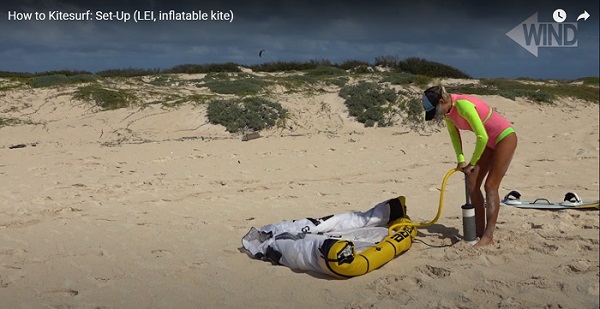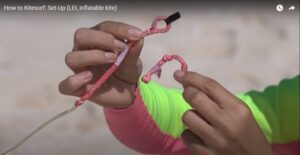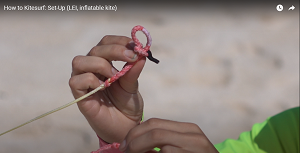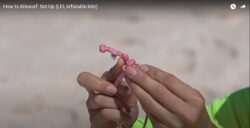If you’ve read my articles on starting out in kitesurfing, you’ll hopefully have had lessons from a professional qualified kitesurfing instructor. One of the first things you learn is how to set up a kitesurfing kite properly.
The technique articles and tutorials I offer here are in no way designed to replace getting lessons.
If you’re anywhere near the North of the United Kingdom, why not check out Northern Kites where you’ll find me teaching alongside the rest of the team whenever the wind is right.
But there’s a lot going on in those first few lessons and it’s always a great idea to brush up on what you learned before getting out on the beach and doing it.
So, in this article I’ll talk you through the best way to set up your bar and lines safely so that your first unsupervised session will start well.
Video Courtesy of Alex at Kitesurf College
Setting up the kite
Positioning
This might sound obvious, but try to set up the kite as close to where you will be launching as possible. This avoids the need to walk across the beach with the kite and lines after you’ve set up.
We’re going to be setting up the lines downwind of the kite so ensure there are no obstacles like sharp bits of rock or other beach users downwind and between the kite and the water.
Inflating the kite
If you haven’t already, carefully get the kite, lines and pump out of the bag.
Always stand with your back to the wind to set up your kite.
Attach the pump leash to the loop you’ll find somewhere near the centre of the leading edge, near the inflation valve.
It’s a good idea to give a couple of pumps before you attach the pump nozzle to the valve, it clears out any sand that might have got inside the tube and avoids getting sand inside the kite bladder.
The majority of modern kites now have a one-pump system where all the struts are connected to the leading edge, so you don’t need to inflate the struts separately. If this isn’t the case with your kite, you’ll need to unroll the kite and weigh down the leading edge with some sand or your board, with the underside of the kite (i.e. the side with the struts and valve on) facing upwards.

The struts need to be pumped up first.
If it is a one-pump system then you can start with the kite only unrolled enough to reveal the inflation valve.
Now you stand with both feet on the rests at the bottom of the pump and inflate the kite a little so that it opens out.
This is a good time to ensure that the bridle lines are all resting on the upturned underside and not looped around the kite.
Now you can pump up the kite fully.
Make sure it’s pumped up to its maximum. It’s pretty difficult to over-inflate the kite, but is possible if you’re using a high capacity pump.
The best way to tell is by checking firstly that there are no creases in either the struts or the leading edge. Give the leading edge a flick and if it’s properly inflated it will make a nice drumming sound.
If your pump has a pressure guage check the required pressure, which is usually on a label somewhere on the leading edge. If not, check the manual.
There are different valves depending on the kite brand, so it’s worth checking how yours works before setting off, but make sure the valve is closed and secured properly. If the kite hits the water or sand hard it can cause the valve closure to pop out or leak if it’s not closed and secured correctly.
Now you should have your fully inflated kite arcing up nicely at the tips and you should be able to hold it by a single point if you’ve got your back directly to the wind.
This is a good time to inspect the kite for any damage. If there is any then don’t go out!
Detach the pump leash, keeping hold of the kite at the same time.
Now walk your way toward a wing tip and rotate the kite, keeping the leading edge into the wind, and place it leading edge down on the ground.
If it’s orientated correctly, the centre strut will be pointing directly downwind.
It’s always a good idea to throw a few handfuls of sand onto the leading edge of the canopy at this point to prevent the kite being picked up by any sudden gusts.
Setting up your kite lines
You can set out your lines either upwind or downwind of the kite, but I always recommend setting them downwind.
Firstly you have a good view of the bridles and easy access to the pig-tails you’ll be attaching the lines to. And secondly with the kite upwind of you when you launch it won’t suddenly power up.
Unrolling the lines
Now unroll a meter or so of the lines and place them on the ground under the upturned kite. I like to weigh these down with a handful of sand, especially if it’s windy. It stops the lines getting blown around as you unroll them.
Now, walking backwards carefully unroll the lines fully.
Bar orientation
Most kite brands operate a system where one end of the bar is coloured either red or another bright colour and the other end a neutral or blue colour.
The red end is left when the kite is in the air.
However, we have placed the kite upside down, so at this point the bar needs to be placed with the red end on the right.
To make it easier, the pig tails on the kite are usually coloured the same as the correct end of the bar for that side. They should be on the same side now.

Untangling and checking the lines
This is probably the most important stage of the set-up.
With your back to the bar step between the outside (steering) lines with the centre line and power lines between your legs.
Hold a steering line and power line between the fingers of each hand and walk slowly towards the kite, allowing the lines to run through your fingers and separate at the same time.
Alternatively (my preferred way), leave the power lines on the ground and just do the steering lines. Then when they are separated and checked, go back and repeat the process with the power lines.
As you run the lines through your fingers you need to be looking and feeling for any kinks, knots, abrasions or frays in the lines. If there are any then you should not go out. Ask an experienced kitesurfer for advice and consider replacing the lines.
Tempting as it is to take a chance, a snapped line will be extremely dangerous and could result in the kite going into a powered-up “death loop”. Trust me…you don’t want that!
At the end of this stage you should have all 4 lines laid out neatly with the ends near the attachment points of the kite.
Attaching the lines
Firstly, pull the bridles out from under the kite and check they aren’t tangled or twisted. If you haven’t already, check also that any pulleys are in good condition and free-running.
Depending on the kite brand, either the end of the kite lines or the “pig-tail” attachments on the kite will have a loop and the corresponding attachment point a knot or series of knots.



You need to make a “larks-head noose” with the looped end. Do this by pushing the section of line just below the loop through the loop to form a noose. You then feed the knotted end through this noose and pull the line to tighten it.
If there is more than one knot, this is to make small adjustments to the line length to slightly change the tuning of the kite. For now, use the second knot, which will probably be about 5cms from the end.
You’re pretty much good to go! Just do one final check from the bar end. Pick up the bar, keeping it in the upside down position (red to the right) and check that the lines aren’t crossed over or snagged on any debris from the beach.
A lot to take in!
Don’t worry! You’ll soon be a dab hand at it. And if you’ve rolled your lines up carefully at the end of your last session then it makes it a lot easier.
But it is worth taking the time to get it right. Cutting corners at this stage could lead to a much shorter kiting session than you’d hoped for.
Leave a Comment
I always love to get feedback on whether my articles are helpful, so please let me know in the comment box below.
And check out my other articles covering everything from kit to kitesurfing locations.
Happy shredding!


Thanks for the insights! Visit Kitesurfing Hurghada if you want to learn the skill, confidence and knowledge of kitesurfing.